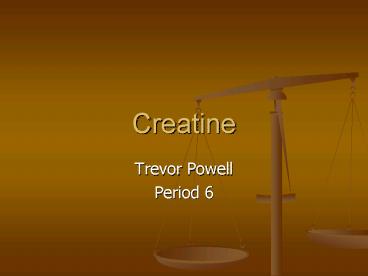Creatine - PowerPoint PPT Presentation
1 / 9
Title:
Creatine
Description:
Discovered in 1835 by French scientist Chevreul. Named after ... Flatulence. Contaminants. Renal stress. Muscle strains, cramps, tears. Future of creatine? ... – PowerPoint PPT presentation
Number of Views:1704
Avg rating:3.0/5.0
Title: Creatine
1
Creatine
- Trevor Powell
- Period 6
2
Quiz Answer Key
- 1-B
- 2-A
- 3-B
- 4-D
- 5-B
- Score out of 5
3
Basics about Creatine
- Creatine is a natural component of skeletal
muscle. - Found in meats, average intake is 1-2mg/day
- Discovered in 1835 by French scientist Chevreul
- Named after Greek word for flesh, Kraes
- First indication that creatine is necessary for
muscular movement was that wild animals had
ridiculously more then caged animals. - Was found that not all creatine ingested came out
in urine - Synthetic creatine can be made
- Monohydrate salt, creatine monohydrate
4
Creatines role in the body
- Creatine is found in amino acids
- Creatine is synthesized in the liver, pancreas
and kidneys - In the muscle, creatine is converted into
phosphocreatine, which is necessary for ATP
production. - Creates waste products creatinine and
dicyandiamide - Pose no harmful risk to body in small amounts
- Series of reactions give muscles energy needed
for movement - Creatine supplements increase storage of fuel
allowing muscles to work harder before becoming
fatigued - Can volumize muscle
5
Synthetic Creatine
- Monohydrate Salt, Creatine monohydrate
- Molecule of Creatine molecule of water
- Muscle volumizing protein synthesis
- Used by athletes who want to increase their
abilities - Not evaluated by the FDA
- Price about 50 or more for a tub (30-60
servings) - Suggested use for neurodegenerative disorders,
neuromuscular diseases, and even increase in
brain power
6
Short term studies
- Females given 20 g/day for 4 days, followed by 5
g/day for 10 weeks showed increased muscle PCr
concentrations by 6. Maximal strength of
certain muscle groups increased by 25, fat-free
mass increased by 60. - Double-blind study provided 20 g/day of creatine
for five days to sprinters and jumpers who jumped
continuously for 45 seconds or ran continuously
for 60 seconds. Their performance increased by
7 for the first 15 seconds, 12 for the next 15
seconds, and no improvement was shown for the
final 15 seconds. There was 13 improvement for
the runners. - Double-blind study supplemented 18.75 g/day for
five days prior, then 2.25 g/day during trials.
The workouts included cycling until exhaustion
using different protocols (1) nonstop, (2) one
minute work, two minute rest, (3) 20 second work,
40 second rest, (4) 10 second work, 20 second
rest. All four categories improved - Study of 81 patients with assorted neurological
diseases found that giving 10 g/day for five
days, then 5 g/day for another week increases
their muscle strength by 10
7
Potential Side Effects
- Long term effects unknown at this time
- French equivalent of FDA has said creatine poses
cancer risk - Dehydration
- Fluid retention
- Can possibly raise blood pressure
- Seizure
- Vomiting
- Diarrhea
- Anxiety
- Myopathy
- Cardiac arrhythmia
- Deep vein thromboses
- Gastrointestinal distress
- Flatulence
- Contaminants
- Renal stress
- Muscle strains, cramps, tears
8
Future of creatine?
- Pressure needs to be put on FDA to evaluate
- Will continue to be commercially available
- More studies need to be done to see if creatine
can help people with certain diseases
9
You decide































